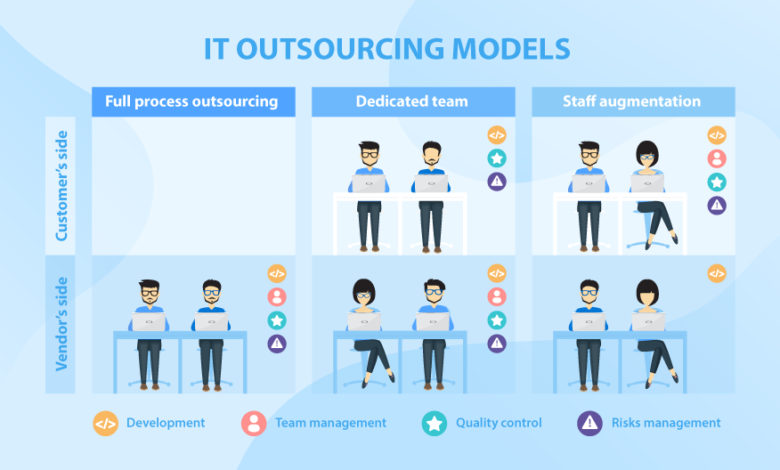The Most Popular 3 Types of IT Outsourcing Models

In this era of technology, everyone does smart work rather than hard work. It saves a lot of time and energy to get the money. Moreover, this technology also brought up the idea of outsourcing. There are many types of outsourcing on the basis of different things. but we will discuss relationship-based types of outsourcing here. Before discussing the types of outsourcing models, we have to know about Outsourcing. Outsourcing is the process of hiring a third party outside of your company to handle certain business activities for you. Outsourcing has become the most powerful form of business during the Covid-19. Many industries like pharmaceuticals, education, and Medicare are boosting up their businesses through outsourcing.
3 Major Types of Outsourcing Mentioned Below:
- Staff Argumentation Model
- Managed Team Model
- Project-Based Model
As we know these models are relationship-based outsourcing models. These models focus on both ownership and the responsibility of the client and third party. It also focuses on the principles that how to handle the partnership. It will help us to know about the role of a vendor, project manager, and developers in the outsourcing models. We will discuss all three models in detail in this article. Let’s begin with the project-based model.
1- Staff Augmentation Model
In this model, a company increases its staff temporarily by calling the developers from outsourcing. The company paid the developers 8 hours per day multiply by the hourly rate. The rate of the developer is fixed with the company before the project started. The company calls each developer once a time for their specific task. The company does not give him the permanent status of the company. The project manager and the client can check the progress of the developer themselves.
The purpose of this model is that if you have a successful iOS app and you want to release its android version. If you don’t have an expert in android, you can hire a qualified android developer. It will be for few months. The benefit is that you don’t go through the traditional hiring process like interviews. Without losing time, you can contact outsourcing companies. They will provide you a professional developer for however long you want. This is why it is also called extended team.
Benefits of Staff Augmentation Model
- You do not need to complete the hiring process. You can expand your team whenever you need.
- The cost of the vendors may be low. All the expenses of the developer are on the vendor.
- You can get high-level developers without giving them office perks and benefits.
- You can control the project to yourself or assign a responsible PM for the project.
2-Managed Team Model
In this model, a client hires a team of specialists to perform specific tasks. The dedicated team does not work with the client’s In-house team but it reports to the clients or their PM. The payment is decided on 8 working hours per day multiplied by the hourly rate. All the terms and conditions are decided before the project started. The dedicated team is called by the clients when they don’t want to do the specific task with their in-house team. The main reason is that the in-house team might not be aware of the specific task. That is why the client does not invest in the in-house team. Here is an example of a fully dedicated team.
- Business analyst
- UI/UX designer
- QA engineer
- 1-2 iOS developers
- 1-2 Android developers
- Back-end developers
- DevOps
The client chooses the required member of the team according to the task. The following are some pros of the dedicated team model.
Benefits of Managed Team Model
- You have more control over the development team because you communicate with them directly.
- The communication between the outsourced teams is reliable because they may know the pace of every member.
- When you choose an experienced tech team, the risk of failure is reduced in the task.
3- Project-Based Model
It is a model in which a client delegates a whole project to an outsourcing party. The software consulting company is responsible for everything from planning to release. The payment method in this model is the total hours require to complete the task multiplied by the hourly rate. These two things decided before the project. This model is commonly use in software development. The project is provided by the vendor to the project manager. The project manager communicates with the team and performs the specific task. The vendor and the PM are fully responsible for the project.
Benefits of Project-Based Model
- Everything in this model is decided before starting the project so that there would be clear timelines and outcomes. Everything plan through UX and UI.
- In this model, the project manager is overseeing so that minimum time committed to the client.
- The project team is just responsible for the specification and required things. The execution and delivery are on the vendor.




